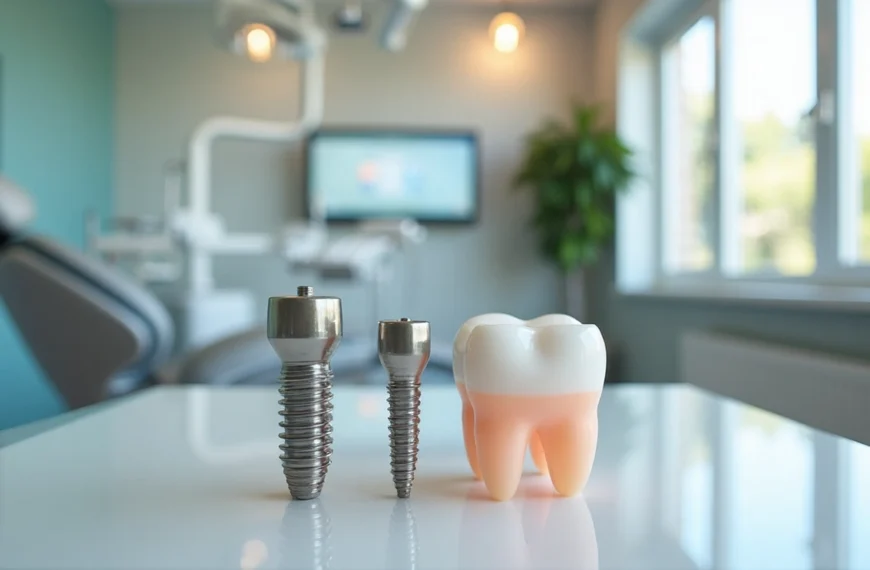Dental plans that cover implants help patients save thousands on procedures that usually cost $3,000 to $5,000 per implant. Most insurance providers require waiting times of six to twelve months for major dental work like implants, making it tough to find coverage without these delays.
Dental insurance with no waiting period costs about $54 per month on average. These plans cost more than standard ones because they start covering procedures right away. The good news is that several dental insurance plans will cover implants without waiting periods in 2025. Not many insurers offer full coverage dental insurance right away, but some do cover implant procedures immediately. The coverage amount changes based on the plan’s annual maximums. Delta Dental’s Premium PPO stands out with a $2,000 annual maximum benefit and a $50 deductible.
This piece shows you which dental insurance plans cover implants and lists the ones with immediate coverage. You’ll learn everything you need to know about getting dental insurance that covers implants right away or dental insurance that covers implants 100 percent. Understanding your options helps you pick the right dental care coverage for your needs.
What Dental Insurance Covers Implants in 2025
Image Source: Blake Insurance Group LLC
Understanding dental insurance coverage for implants depends on how plans categorize different procedures. Most dental insurance plans split coverage into three main categories that come with different coverage levels.
Basic vs major dental care coverage
Dental plans sort treatments into preventive, basic, and major categories. Preventive services like exams, cleanings, and x-rays get 100% coverage. Basic services such as fillings, prefabricated crowns, and simple extractions usually receive 70-80% coverage. Major services that cover complex procedures like crowns, bridges, and dental implants typically get reimbursed at just 50%.
Dental implants belong to major dental care because they need complex procedures and cost more. Insurance providers in 2025 still classify dental implants as major restorative care, which means patients face the highest out-of-pocket costs.
Implant-specific coverage explained
Plans that cover implants usually pay for specific parts of the implant process. The coverage extends to:
- The implant itself (the titanium post surgically placed in the jawbone)
- Abutments that connect the implant to the crown
- The crown that serves as the visible tooth replacement
- Related procedures like bone grafts and consultations
Coverage limits apply in most cases. GEHA’s High plan caps implant coverage at $2,500 per person yearly for both in-network and out-of-network care. Standard plans might give $2,500 for in-network and $2,000 for out-of-network services.
Common exclusions to watch for
Implant coverage has improved, but many exclusions still exist. Plans often don’t cover:
- Pre-existing conditions (missing teeth before coverage began)
- Original placement of implants (some only cover replacement)
- Services deemed “not necessary” or without “uniform professional endorsement”
- Cosmetic procedures related to implants
Plans also require waiting periods before implant coverage starts, usually 6 to 18 months. Annual maximums create another restriction, as most plans limit benefits to between $1,000 and $3,000 yearly. Some plans like Physicians Mutual skip annual limits but restrict lifetime implant coverage to $1,000.
Top Dental Insurance Plans That Cover Implants With No Waiting Period
Image Source: CarePlus Dental Plans
You’ll need to research carefully to find dental plans that cover implants with no waiting period. The good news is several insurance companies now cover implants right away in 2025, so you can get your dental work done without long delays.
1. Spirit Core PPO
Spirit Dental’s Core PPO plan stands out as a great option that covers implants the moment you enroll. The plan gives you 25% coverage for implants in the first year and jumps to 50% in later years. You’ll get a $1,200 annual maximum with a lifetime deductible of $100, which makes it affordable over time. The plan covers three cleanings and two exams at 100%, showing its commitment to preventive care among other major services.
2. PrimeStar Lite
Ameritas’s PrimeStar Lite plan skips waiting periods for major services, including dentures, with modest coverage to start. Major services get 10% in-network coverage in year one, which grows to 20% after that. The annual maximum starts at $750 and doubles to $1,500 after your first year. This plan works best if you want to maintain good oral health with simple coverage for major work.
3. DentalWise 1000
UnitedHealthcare’s DentalWise 1000 charges a $100 deductible per person without any waiting period for basic services. It’s worth mentioning that this plan doesn’t cover dental implants, so it won’t help if you specifically need implant coverage.
4. Essential Choice PPO Incentive
Anthem’s Essential Choice PPO Incentive plan takes an innovative approach without waiting periods for any services, including major procedures. Your benefits for basic and major services increase in following years when you get preventive care. The plan’s annual maximum benefit reaches $250,000 – one of the highest available.
5. Ridge Plan
Denali’s Ridge Plan grows your implant coverage over time. You start with 10% coverage in year one, and this climbs to 50% by year four.
6. Loyalty Plus
Humana’s Loyalty Plus plan boosts your benefits without waiting periods. The plan’s maximum begins at $1,000 in the first year and increases to $1,500 by year three. Your coverage percentages also improve the longer you stay with the plan.
Comparing Plan Features That Matter Most
Image Source: Insurance
Selecting dental insurance for implants requires careful comparison of plan features that affect both coverage quality and out-of-pocket costs. A thorough understanding of these features helps consumers make better decisions based on their dental needs.
Waiting period length and exceptions
Insurance providers have different waiting periods for implant coverage:
- Six months: Delta Dental stands out with one of the shortest waiting periods at just six months, which beats the industry standard
- Twelve months: MetLife and several competitors need a full year before covering implants
- Eighteen months: Plans like DentaQuest require longer waiting periods
The waiting period might be waived under specific conditions, such as switching plans with the same insurer or continuing employer-based coverage without gaps.
Coverage percentage for implants
Plans typically cover 50% of implant costs after meeting the deductible. Spirit’s Core PPO starts with 25% coverage in year one and increases to 50% afterward. United Healthcare’s Premier Plus begins at 10% coverage initially, grows to 40% after one year, and reaches 50% after two years.
Annual maximums and lifetime caps
The annual maximum benefits range between $1,000 and $2,000 per year. Patients become responsible for additional dental expenses after reaching this maximum until the next plan year. Delta Dental’s $2,000 maximum provides 25% more coverage than MetLife’s $1,500 limit. Several plans set lifetime caps specifically for implant procedures, whatever the annual limits.
Customer satisfaction and complaint rates
DentaQuest stands out with complaint numbers nowhere near what’s expected for its size, ranking best among 13 researched companies. Spirit ranks below nine other companies in customer complaints. MetLife scored 775 out of 1,000 in J.D. Power’s dental insurance survey, which falls below the industry’s 782 average.
How to Choose the Right Plan for Your Needs
The right dental insurance for implants depends on several important factors. We learned that knowing how to evaluate plan features can save you thousands of dollars and help avoid unexpected coverage gaps.
Assess your current and future dental needs
You should evaluate your oral health situation before looking for dental insurance that covers implants. Think about whether you need one implant or multiple procedures. A review of your current dental condition helps you figure out if you need extra services like bone grafting or extractions with implants. Your dentist’s input about implant needs makes a big difference—they can give you a detailed treatment plan and cost estimate. This professional input serves as great documentation when you talk about coverage options with insurers.
Check if your dentist is in-network
Working with a dental provider in your insurance network can cut costs. Delta Dental has over half a million in-network dentists across the country. Network providers often save you money through better rates and higher coverage percentages. The data shows patients pay much more when they go to dentists outside their dental plan’s network. You should first check if your preferred implant specialist works with the insurance networks you want. Some plans like BCBS FEP Dental have huge networks with 99.9% of members having at least one in-network dentist within 15 miles.
Understand the fine print before enrolling
Take time to review policy details before you sign up for any dental plan. Look out for:
- Cost sharing arrangements: Most insurers only pay a percentage of implant costs, typically up to 50% of the total
- Waiting periods: Determine if the plan has waiting periods or offers immediate coverage
- Annual or lifetime maximums: Check limits on how much the plan will pay for implants
- Pre-existing condition restrictions: Many plans won’t cover teeth missing before policy activation
- Frequency limitations: Some insurers limit how often certain procedures are covered
Make sure to call your dental insurance provider to confirm all coverage details, including out-of-pocket costs and limitations.
Conclusion
Making the Most of Dental Implant Insurance in 2025
You need solid research to find dental plans that cover implants with no waiting periods. This piece dives into dental insurance coverage for implants. We look at everything from simple vs. major dental care classifications to the best providers offering immediate coverage.
Dental implants don’t come cheap. Most people pay $3,000 to $5,000 per implant. The right insurance plan helps manage these costs well. Spirit Core PPO and Anthem’s Essential Choice PPO Incentive lead the pack for immediate implant coverage. Each plan comes with different coverage percentages and yearly maximums.
Your actual implant costs depend on several factors. These include yearly maximums, coverage percentages, waiting period exceptions, and available in-network providers. Spirit’s graduated coverage approach starts at 25% and grows to 50% over time. Delta Dental takes a different route with higher yearly maximums at $2,000.
Your specific dental needs should guide your choice of insurance. A chat with your dentist before picking insurance can give you great insights. They’ll map out your treatment plan and estimate costs based on your situation. This information helps you talk through coverage options with insurance companies.
The fine print matters more than you might think. Restrictions on pre-existing conditions, frequency limits, and cost-sharing can change your coverage quality. Some insurers won’t cover teeth missing before your policy starts. Others limit how often you can get certain procedures.
Finding dental insurance for implants without waiting periods isn’t simple, but good options exist in 2025. This guide gives you the tools to pick the right dental coverage. You could save thousands on implant procedures while taking care of your oral health properly.
FAQs
Q1. What are the best dental insurance options for implants without waiting periods in 2025? Several plans offer immediate coverage for implants. Spirit Core PPO provides 25% coverage in the first year, increasing to 50% later. Anthem’s Essential Choice PPO Incentive has no waiting periods for any services. Other options include PrimeStar Lite and Humana’s Loyalty Plus, which offer varying levels of immediate coverage for major dental work.
Q2. How can I maximize my insurance coverage for dental implants? To maximize coverage, start by getting a detailed treatment plan and cost estimate from your dentist. Check if your preferred dentist is in-network with your insurance plan. Review policy details carefully, paying attention to cost-sharing arrangements, waiting periods, and annual maximums. Consider plans with higher annual maximums, like Delta Dental’s $2,000 limit. Always confirm coverage details directly with the insurance provider before proceeding with treatment.
Q3. What are some alternatives if I can’t afford dental implants? If dental implants are financially out of reach, explore alternative financing options. Some dental offices offer payment plans or partner with third-party financing companies like CareCredit, which can provide interest-free financing for a specific period. Additionally, consider dental schools or clinics that may offer reduced-cost implant procedures. Some dental plans also offer increasing coverage over time, which could make implants more affordable if you can wait.
Q4. How do dental insurance plans typically categorize implant coverage? Most dental insurance plans categorize implants as major dental care, along with procedures like crowns and bridges. This classification usually means implants are covered at a lower percentage, typically around 50% after meeting the deductible. Coverage often includes the implant itself, abutments, crowns, and related procedures like bone grafts. However, many plans impose annual maximums and may have specific exclusions or limitations for implant coverage.
References
[1] – https://www.investopedia.com/how-to-get-dental-implants-covered-by-insurance-8580639
[2] – https://www.investopedia.com/the-best-dental-insurance-for-implants-11679630
[3] – https://www.forbes.com/advisor/health-insurance/dental-insurance/best-dental-insurance-for-implants/
[4] – https://www.cigna.com/static/www-cigna-com/docs/co-ind-policy-family-pediatric-dental-exclusions-and-limitations.pdf
[5] – https://www.dentalplans.com/blog/what-dental-insurance-doesnt-cover/
[6] – https://www.humana.com/dental-insurance/dental-resources/dental-insurance-waiting-period
[7] – https://spiritdental.com/dental-insurance/core-ppo-dental-plan
[8] – https://www.forbes.com/advisor/health-insurance/dental-insurance/spirit-dental-insurance-review/
[9] – https://www.forbes.com/advisor/health-insurance/dental-insurance/ameritas-dental-insurance-review/
[10] – https://www.ameritas.com/OCM/GetFile?doc=647311
[11] – https://www.utahavenue.com/health-insurance-plans/2024/dental/uhc-dentalwise-1000-2024
[12] – https://www.dentalinsurance.com/anthem-bluecross-blueshield/essential-choice-incentive/
[13] – https://www.tridentsmilesdental.com/blog/how-to-get-dental-implants-covered-by-insurance
[14] – https://www.humana.com/dental-insurance/loyalty-plus-dental-ppo-plan
[15] – https://minnesotahealthagents.independenthealthagents.com/humana-loyalty-plus-dental-plan/
[16] – https://blyssdental.com/does-dental-insurance-cover-dental-implants-in-2023/
[17] – https://www.deltadental.com/us/en/protect-my-smile/dental-insurance-101/what-is-dental-insurance-annual-maximum.html
[18] – https://sweetwatersmile.com/who-has-the-best-dental-insurance-for-implants/
[19] – https://www.deltadental.com/us/en/member/find-a-dentist.html
[20] – https://www.bcbsfepdental.com/findadentist













![No Win No Fee Lawyers: The Hidden Truth About Settlement Cuts Legal representation through no win no fee lawyers gives clients a way to fight cases without paying anything upfront. Many clients don't know that these services take a big chunk of money after winning the case. Lawyers usually take 25% to 40% of what you win as their contingency fee. The amount lawyers take from settlements can add up fast. A $100,000 settlement means your attorney gets $30,000 if they charge a 30% fee after winning your case. Your solicitor's cut might be £10,000 from a £30,000 compensation award, based on your agreement percentage. This payment model stays pretty much the same for no win no fee lawyers in different places, though percentages can change. This piece breaks down what you need to know about contingency fee deals. You'll learn about standard fee ranges, extra costs beyond the basic fee, and times when this payment setup might not work in your favor. Smart clients should think over these money matters before signing up with a lawyer to make better choices about their legal help. What No-Win No-Fee Really Means Image Source: Express Legal Funding A no-win no-fee arrangement, also called a Conditional Fee Agreement, changes the way people get legal help. This payment approach removes the need to pay legal fees upfront and creates a partnership between clients and their attorneys. How contingency fees work No-win no-fee agreements are based on contingency fees. Lawyers get paid only when they win compensation for their clients. Most lawyers take between 25% and 40% of the final amount, based on how complex the case is and where it's filed. Lawyers take their cut after winning the case. To name just one example, see a case where a lawyer wins £30,000 in compensation with a 33% fee - they would receive £10,000. On top of that, some law firms use sliding scales where they charge less for quick settlements and more if the case goes to trial. The law requires a written agreement before any work starts. This paperwork spells out the lawyer's percentage, what costs you'll need to cover, and other key details. What happens if you lose the case The meaning behind "no-win no-fee" is clear - losing your case means you won't pay your lawyer anything. All the same, you should know about a few money-related details. You won't owe your lawyer when you lose, but some deals might make you pay for court fees, expert witnesses, or other case expenses. The other side could also ask you to pay their legal costs. Many lawyers suggest getting "After Event" insurance to protect their clients. These policies cover any costs if you lose your case, which makes the no-win no-fee setup much safer. Why lawyers offer this model Lawyers want to make legal help available to more people, so they offer these payment plans. This setup helps people who don't have much money take legal action when they have valid claims. The payment structure motivates lawyers to work hard. They only get paid by winning cases, which pushes them to get the best results possible. Lawyers carefully assess each case before taking it on a no-win no-fee basis. They usually accept cases that have a good chance of winning, since they put in lots of time and resources without any guaranteed payment. The Real Cost: How Much Do Lawyers Take from a Settlement Image Source: Greiner Law Corp. The true cost of no-win no-fee legal representation becomes clear once we look at contingency fees. Many clients feel surprised to see a big chunk of their settlement checks going to their attorney's fees. Typical percentage ranges (25%–40%) No win no fee lawyers typically ask for 25% to 40% of the total settlement amount. Personal injury attorneys usually take 33.3% (one-third) of the awarded compensation[101]. Lawyers and clients agree on this percentage before any work starts on the case. Several factors shape the final percentage. Your chances of winning, case complexity, and the work to be done play key roles in determining the attorney's cut. Some areas have laws that cap the maximum contingency fees for specific types of cases. Sliding scale based on case complexity Law firms often use a tiered fee system that changes with the case stage and complexity. This scale rewards quick settlements while paying attorneys fairly if more work becomes needed. The fee might start at 30% if the case settles before lawsuit filing. This number could climb to 35% after filing or reach 40% if the case goes to trial. Law firms often group cases by complexity: 10%-20%: Simple cases with straightforward settlements 25%-35%: Typical personal injury cases 35% and above: Complex cases requiring extensive resources Examples of payout breakdowns These ground examples show how fees affect settlements: A $15,000 settlement with a 33.3% contingency fee.pdf) puts $5,000 in the attorney's pocket, leaving $10,000 for the client. Similarly, from a $100,000 settlement with a 33% fee, the attorney gets $33,000 while the client receives $67,000[102]. Complex cases tell a different story. A $100,000 settlement with a 30% fee plus $5,000 in extra costs leaves $65,000 for the client after all deductions. These fees substantially change the client's final payout. Hidden Costs You Might Not Expect Image Source: Nelson Personal Injury Lawyers Beyond percentage-based fees, clients often feel surprised by extra costs that can reduce their final compensation by a lot. These hidden costs show up in the fine print of no-win no-fee agreements. You should think over these details before signing. Court filing and expert witness fees Legal proceedings come with unavoidable court filing fees. These charges differ by jurisdiction. They usually range from $30 for small claims to several hundred dollars for complex civil lawsuits. Expert witnesses can be expensive, with hourly rates ranging from $150 to $1,000 based on their credentials and testimony complexity. Expert witnesses charge more for court appearances than consultation work because of added pressure and prep time. Clients might still need to pay experts for their prep work even if the case settles before trial. Medical report and investigation costs Medical documentation is a vital part of many legal claims. These costs include fees to release medical records, create specialized reports, and prepare documents. Investigation costs cover evidence gathering, police reports, witness interviews, and other fact-finding work needed to build a strong case. Of course, some firms say they'll cover these expenses upfront, but clients don't completely avoid these costs. When these costs are deducted from your compensation Law firms take these expenses from the settlement amount before they calculate their percentage fee, though each firm handles this differently. Some lawyers subtract these costs after figuring out their contingency fee, which changes how much money clients end up with. Most firms pay case-related costs during the process and get their money back from the settlement. The defendant usually pays most simple legal costs and disbursements in successful cases, but not always everything. Insurance protects clients from costs in unsuccessful claims at many law firms, but this protection isn't guaranteed. Clients should review their agreements carefully since they might still need to pay specific expenses even if they lose their case. When No-Win No-Fee Might Not Be the Best Option Contingency fee arrangements give many people access to justice. However, this payment model doesn't always work in a client's best interests. Knowing these limitations helps clients make better decisions about their legal representation. Cases with unclear liability Lawyer no win no fee arrangements work best in cases where fault is clear. We assessed the probability of success before taking contingency cases. Lawyers might turn down cases if there isn't enough evidence of the other party's negligence or if liability isn't certain. Cases with multiple responsible parties create more challenges. The situation gets complicated fast when several parties share liability. Lawyers are less likely to take these cases on contingency. They need to be confident they can prove the other party's negligence before accepting a case. Low-damage or low-payout claims Small claims often don't work well with the contingency model, even with real injuries. Cases that have minimal injuries or limited financial damages might not bring enough compensation to cover legal costs. The potential settlement needs to be big enough to pay for investigations, witness interviews and court fees. Personal injury lawyers often turn down cases where the "compensation potential" is too small. This doesn't mean the claim isn't valid - it just means the economics don't add up for a contingency arrangement. Situations where hourly billing may be better Hourly billing has clear advantages in certain cases. Clients see exactly what they're paying for - every hour worked and task completed. This model works well for cases that need lots of attention but don't have clear financial outcomes. Complex litigation with opposing parties works better with hourly billing and a retainer fee. Clients have more control over their case and don't feel pressured to settle quickly. Cases that need extensive preparation but have uncertain outcomes fit the hourly model better. Lawyers can spend the time needed without worrying about contingency limits. This approach often leads to better representation, especially for complex legal issues that need special expertise. Conclusion Understanding the Full Picture Before You Sign No-win no-fee arrangements offer legal representation without upfront costs. Of course, this seems attractive at first glance. In spite of that, you need to think about how these agreements can affect your final compensation. Legal fees usually range from 25% to 40% of your settlement - but that's just the start. You'll face more deductions like court filing fees, expert witness costs, and charges for medical documentation. What looks like a "free" service ends up taking a big chunk of your compensation to cover legal expenses. These arrangements work best in specific situations - cases with obvious liability, substantial damages, and solid evidence. If you have a low-value claim or complex liability issues, traditional hourly billing might serve you better. Without doubt, you should ask for clear explanations of all possible costs before signing anything. Read the fine print closely, especially when you have to deal with expenses in unsuccessful cases. Ask to see sample settlement breakdowns that show all deductions. This helps you picture what you might actually take home. Your choice to go with a no-win no-fee arrangement depends on your situation. This model helps if you don't have money to pursue valid claims. But if you have a strong case and enough funds, other fee structures might let you keep more of your compensation. Whatever payment model you choose, knowing exactly how much lawyers take from settlements helps you make better decisions. This knowledge lets you approach legal representation with real expectations and better control over your money. FAQs Q1. What percentage of a settlement do no-win no-fee lawyers typically take? No-win no-fee lawyers typically charge between 25% to 40% of the final settlement amount as their contingency fee. The exact percentage often depends on the complexity of the case and the stage at which it is resolved. Q2. Are there any hidden costs in no-win no-fee arrangements? Yes, there can be additional costs beyond the lawyer's percentage fee. These may include court filing fees, expert witness costs, medical report expenses, and investigation costs. These expenses are usually deducted from the settlement amount before or after the lawyer's fee is calculated. Q3. What happens if I lose my case in a no-win no-fee arrangement? If you lose your case, you generally won't have to pay your lawyer's fees. However, you might still be responsible for certain expenses like court costs or the opposing party's legal fees. Many lawyers offer insurance to protect clients from these potential costs in case of an unsuccessful claim. Q4. When might a no-win no-fee arrangement not be the best option? No-win no-fee arrangements may not be ideal for cases with unclear liability, low-value claims, or complex legal issues requiring extensive preparation. In these situations, traditional hourly billing might be more appropriate and potentially more cost-effective for the client. Q5. Can I negotiate the percentage a lawyer takes from my settlement? Yes, the contingency fee percentage is often negotiable. It's typically agreed upon and formalized in writing before the lawyer begins working on your case. Don't hesitate to discuss the fee structure with your lawyer and ask for a detailed breakdown of potential costs and deductions.](https://consumersweek.com/wp-content/uploads/2025/06/No-Win-No-Fee-Lawyers-The-Hidden-Truth-About-Settlement-Cuts-870x570.webp)


